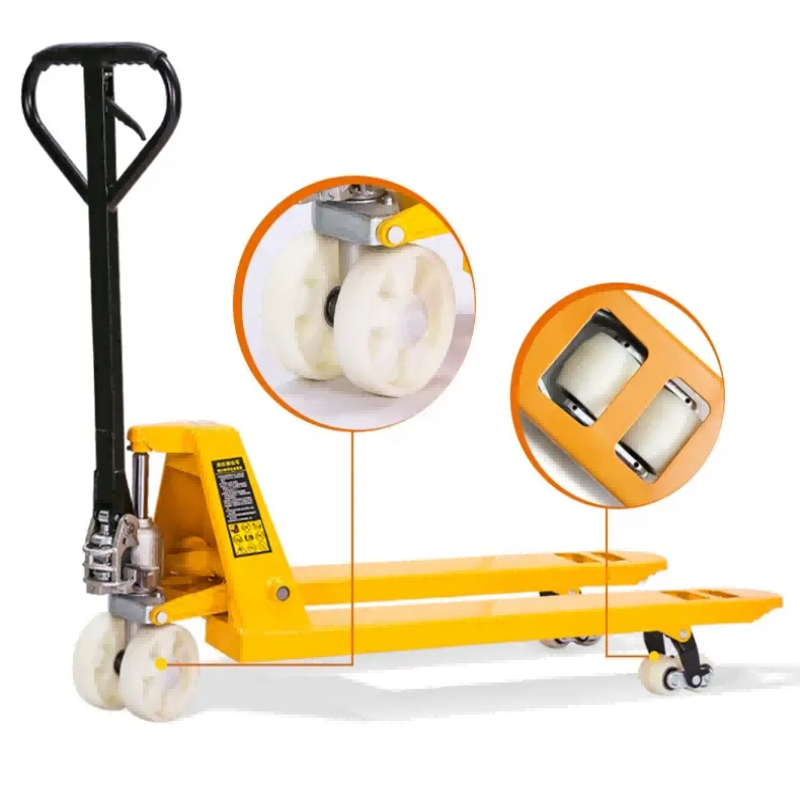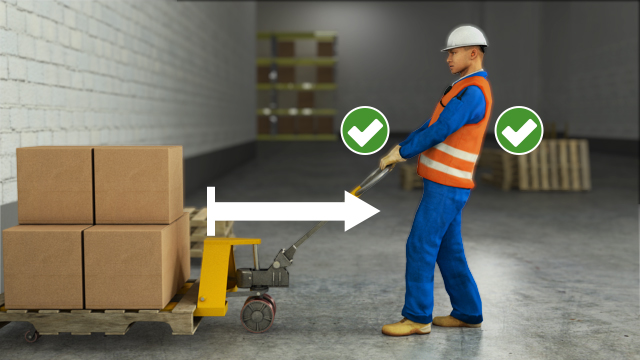allet Truck, also known as a manual pallet jack or hand pallet truck, is a common material handling tool used for transporting and stacking goods in warehouses, industrial settings, and more. The main components of a Pallet Truck typically include:
Forks: The forks are the essential components of the Pallet Truck, usually made of sturdy steel. They are the two-pronged horizontal beams used to support and slide under the pallet or platform of the goods.
Jack: The jack is the lifting mechanism of the Pallet Truck, often powered by a hydraulic system. By operating the handle, the hydraulic system raises or lowers the jack, lifting or lowering the forks to lift or place the load.
Handle: The handle is the control device of the Pallet Truck, typically located at the top of the truck. The operator pushes or pulls the handle to control the movement and lifting actions of the Pallet Truck.
Wheels: Pallet Trucks are usually equipped with two or four wheels. The front wheels are responsible for steering and guiding, while the rear wheels are used for propulsion and supporting the weight of the Pallet Truck.
Tiller: The tiller is another control device of the Pallet Truck, located at the end of the handle. By operating the tiller, the operator can easily control the turning and direction of the Pallet Truck.
Brake System: Some Pallet Trucks are equipped with a brake system for safe parking. These brakes can be foot-operated or manual, ensuring the Pallet Truck can come to a quick stop when needed.
Load Protector: Some advanced Pallet Trucks come with a load protector to maintain balance while lifting loads, preventing goods from tilting or toppling.
The above components work together to make the Pallet Truck an efficient, convenient, and safe material handling tool widely used in various warehouses and logistics settings. Different types of Pallet Trucks may have slight variations, but the overall structure and functionality are generally similar.
Pallet trucks are commonly used in warehouses and industrial settings, but they can pose risks if not operated safely. To ensure the safe use of pallet trucks in the workplace, follow these simple guidelines:
Check the Truck: Before using the pallet truck, inspect it for any signs of wear and tear. Ensure that the hydraulics used to raise and lower the forks are in good working condition. Consider having a second person check the truck for any missed issues.
Respect Load Limits: Every pallet truck has a load limit clearly marked on the side. Never exceed this maximum capacity, which can range from 250kg up to 2500kg. Overloading the pallet truck can cause it to tip over, resulting in damage to equipment or injury to staff. Use a weighing scale to ensure loads are within the safe limit.
Avoid Ramps: Whenever possible, avoid moving heavy loads up or down inclines. Keeping the truck balanced is crucial for safety. If you must navigate a ramp, keep the load ahead of the operator when moving uphill to maintain balance. Keep the forks raised about 4-6 inches above the ground to prevent catching when entering or leaving the ramp.
Use Brakes: Some pallet trucks have brakes for safe stopping, while others require manual stopping. Ensure you have enough stopping distance when slowing down, and choose a stopping area away from pedestrians. Remember that pallet trucks carry momentum when loaded, so slowing down may take some time and distance.
Pull, Don't Push: Contrary to common belief, it's better to pull loads across a flat surface for increased maneuverability. Pulling allows the operator to watch for hazards ahead, such as pedestrians. Pushing from behind can be tiring and obstructs the view of potential obstacles on the ground or forks getting caught.
Store Safely: After unloading, lower the forks and make sure they are not pointing outward at an angle, becoming a hazard. Store the pallet truck in the designated area. If not possible, place it close to a wall, with the forks not pointing into hallways or walkways.
By following these safety guidelines, you can operate a pallet truck securely. Check out our range of pallet trucks, stackers, and other heavy lifting equipment to find the product that suits your needs.
Our website: www.sharehoist.com
Whatsapp;+8617631567827
Post time: Jul-31-2023










